Annual Report 2003 2004
Annual Report 2003 2004
Annual Report 2003 2004
Create successful ePaper yourself
Turn your PDF publications into a flip-book with our unique Google optimized e-Paper software.
122<br />
The strongly export-dependent German economy in particular would<br />
be adversely affected by a greater than expected slow-down in the<br />
world economy, all the more so as domestic demand in 2005 will only<br />
see moderate growth, meaning that there can still be no talk of a selfsupporting<br />
upward trend. With regard to economic policy, there is a risk<br />
that the reform efforts to strengthen Germany’s competitiveness will<br />
lose momentum.<br />
Segment risks<br />
The Steel segment counters the risks arising from cyclical trends in<br />
the steel business by optimizing costs, adjusting production in a<br />
timely manner and concentrating on exacting market segments. To<br />
counteract financial risks through increased insurer’s premiums, the<br />
Steel segment has integrated property insurance-related economic<br />
and technical risk monitoring into the risk management process. To<br />
further optimize preventive fire safety, common minimum standards<br />
have been defined for the entire segment.<br />
Quality and delivery deadline risks are minimized through the<br />
optimization of the value chains. The segment counteracts currency<br />
risks arising from procurement and sales transactions through<br />
hedging.<br />
The main risks for the Carbon Steel business unit include market<br />
risks regarding sales and procurement, risks from loss of production<br />
and increased expenditure for repairs following equipment breakdowns,<br />
as well as currency exchange rate fluctuations.<br />
The business unit reduces the risk of limited core markets through<br />
globalization of manufacturing in downstream activities and enhanced<br />
internationalization of sales. The business unit counteracts the high<br />
competitive intensity in the market for carbon flat steel products<br />
through its innovation strategy, allowing competitive advantages to<br />
be attained, at least temporarily. The risk of rising raw material<br />
prices (caused by the growth in demand on the Chinese market<br />
(particularly for coke, ore and scrap, can only be counteracted to a<br />
limited extent by alternative procurement sources and/or by passing<br />
the prices on. Preventive maintenance, modernization and investments<br />
work against the risk of an unplanned production standstill.<br />
The Stainless Steel business unit is confronted with risks arising<br />
on the one hand from market developments, particularly in Europe<br />
and China, and on the other hand due to expected overcapacity in<br />
stainless production, exacerbated by changes in worldwide supply<br />
flows through existing or new access barriers to major markets outside<br />
Europe. The companies of this business unit curtail such risks<br />
through measures of distribution, capacity and production control.<br />
Rising competitive pressure is countered by the development of new<br />
applications for stainless steels and nickel-base materials and<br />
innovative products from these materials, as well as modern and<br />
cost-saving process technologies. Beyond this, all subsidiaries of the<br />
business unit are strengthening their customer relationships through<br />
customer-centric service offerings, further quality improvements and<br />
better delivery performance.<br />
The risks arising from the availability and the price development of<br />
raw materials, especially for nickel and alloyed scrap, are minimized<br />
by means of adequate contracts and assurance mechanisms.<br />
The Automotive segment is lowering its dependence on regional<br />
markets by an increasing global presence, in particular in growth<br />
regions such as Asia and Latin America. Regardless of this, due to<br />
the current sales structure, further developments in North America<br />
are particularly important for the segment.<br />
An ambitious segment-wide cost reduction program has been<br />
introduced to compensate for increasing price pressure from<br />
automotive manufacturers. The effects of these measures will be<br />
strengthened by improvements in earnings from restructuring<br />
measures introduced in the previous years.<br />
Sales and earnings in the past fiscal year were affected by the<br />
strengthening of the euro against the us-Dollar and the Brazilian Real.<br />
The structural market development was characterized by<br />
concentration trends on the part of automobile manufacturers and<br />
competitors. ThyssenKrupp Automotive counteracts such trends<br />
through dynamic internal and external, quantitative and qualitative<br />
growth.<br />
Automotive is countering possible risks arising from the<br />
discontinuation of existing manufactured automotive products through

















